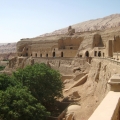- Information
- Traveler Advice
- Forums
48HourVisit.com
 Planning a short visit? Check out 48HourVisit.com, your online guide for short stays and weekend getaways.
Planning a short visit? Check out 48HourVisit.com, your online guide for short stays and weekend getaways. Ad
The Glossary
Perched in the Mongolian Uplands northwest of China, Xinjiang is the heart of Eurasia, the heartland of the nomadic Uyghur tribes, and the cultural bridge between the East and the West during the cheery days of the ancient Silk Road. This sparsely-populated province eats one-sixth of China's total land mass, about the size of the whole Western Europe or Iran, thereby providing a spacious arena for tourists to discover terrains like dry steppes, oases, lakes, valleys, nature reserves, deserts and more, that are as varied as the culture and the folklore thriving in them.
Since Xinjiang borders Russia to the north, Tibet and India to the south, Gansu and Qinghai in the southeast, and Kyrgyzstan, Kazakhstan, Tijikistan, Pakistan, and Afghanistan to the west, the province is a gateway to these regions and countries as well as a shortcut to these places' people and culture.
Many immigrants from Xinjiang's bordering nations have found a home in Urumqi, the provincial capital and home to the mummies of the Xinjiang Uyghur Regional Museum; parks and temples of Hongshan (Red Mountain); hot springs of Shuimugou; Silk Road history at Xinjiang Museum, and to Russian and Mongolian artworks of Erdaoqiao market.
During the Tang and Han Dynasties, silk and other products were shipped to Xi'an, where Silk Road began, before being transferred to caravans en route to Xinjiang, where there are routes leading to Europe's Hexi Corridor without having to pass the Taklimakan Desert. These three routes can still be explored today.
The first of the routes straddles along Kashgar and Turpan, towns included in northwestern Xinjiang's "land of carpets, song, dance, succulent melons, grilled lambs, and precious stones." Kashgar is a 1000-kilometer desert town lying at the tail end of China, making it known as "The End of China's New Frontier." It serves as the cultural crossroads between diverse ethnicities, including the Han Chinese, Uyghurs, Tajiks, Uzbeks, and Kyrgyz, whose kilims (carpets), doppa and kalpak hats, and other arts and handicrafts, have made the city the largest bazaar in Asia. Turpan, meanwhile, has the Earth's second lowest point (Turpan Depression) and China's hottest place, Flaming Mountain.
Unique landscapes, habits and customs are the promises held by the second path, which includes Hotan and Kuqa. Kuqa is a historic interest area for its grottoes while Hotan is an oasis town with three rivers that provided sustenance to survive the world's "Death Sea" or second-largest desert, the Taklimakan.
Xinjiang photography
 no title by Barak
no title by Barak
 no title by Barak
no title by Barak
 no title by Barak
no title by Barak
 no title by Barak
no title by Barak
 no title by Barak
no title by Barak
User blogs:

Loving Laos
Laos seems like a long shot to become Southeast Asia’s next big thing. The food doesn’t win any prizes, the roads are severely potholed by frequent flooding and locals regard the prospect of increased tourism with a sunny indifference that exceeds even Mediterranean proportions. Laos is the least developed and most enigmatic of the three former French Indochinese states ... Read full Blog post
Destinations
See All- Hotan
- Karghilik
- Kashgar
- Kuqa
- Northern Xinjiang
- Southern Silk Road
- Southwest Xinjiang Kashgaria
- Tacheng
- Turpan
- Yarkand
- Yengisar
- Yining
- More destinations
In our Magazine
Summer Destination to Avoid: Gulf of Mexico
 EPA is failing to do their job monitoring the air and reporting factual data. The people need to be made aware that their lives and long term livelihood are at stake because of the air quality in Gulf of Mexico.
EPA is failing to do their job monitoring the air and reporting factual data. The people need to be made aware that their lives and long term livelihood are at stake because of the air quality in Gulf of Mexico.
How to Avoid Traveling Troubles
 Traveling to a certain destination might not become memorable if there are too many troubles along the way. Remember that even the best trips are usually not trouble-free. Follow these tips that help lessen the hassles.
Traveling to a certain destination might not become memorable if there are too many troubles along the way. Remember that even the best trips are usually not trouble-free. Follow these tips that help lessen the hassles.
Unique Toys from Japan
 Japan is known for its fascinating, and sometimes, eccentric culture. From anime, karaoke, to advanced technology, the Land of the Rising Sun always has something unique to offer.
Japan is known for its fascinating, and sometimes, eccentric culture. From anime, karaoke, to advanced technology, the Land of the Rising Sun always has something unique to offer.




